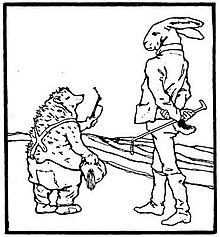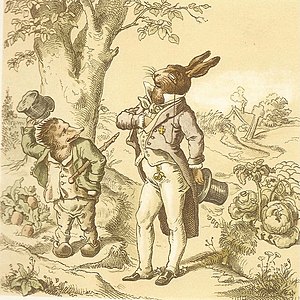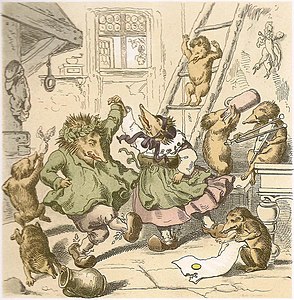The rabbit and the hedgehog

The Hare and the Hedgehog is a farce ( ATU 275C). In the Grimm Brothers' Children's and Household Tales from the 5th edition from 1843, it is in place 187 (KHM 187) in Low German and comes from Wilhelm Schröder's Hannoversches Volksblatt from 1840 (A Low German folk tale. Dat Wettlopen between the rabbits and the Swinegel up de lütje Heide bi Buxtehude) . Ludwig Bechstein took over the animal swank in his German fairy tale book from 1853 as The Race between the Hare and the Hedgehog in High German (No. 60).
content
One fine morning the hare makes fun of the hedgehog's crooked legs , whereupon the hedgehog challenges him to a race to win a golden “Lujedor” ( Louis d'or ) and a bottle of brandy. When the race in the field begins, the hedgehog only takes a few steps, but at the end of the furrow has placed his mistakenly looking wife. When the rabbit, who is certain of victory, rushes up, the hedgehog's wife rises and calls to him: “Ick bün all here!” (“I'm already here!”). The hare cannot understand the defeat, he demands revenge and runs a total of 73 runs with always the same result. In the 74th race he collapses exhausted and dies.
style
The narrator begins mischievously that the story is “to tell lies” (“to tell lies like a lie”), but his grandfather said it had to be correct, otherwise it could not be told (“'Be true, mien son, anners kunn man se jo nich vertellen '"), and tells comfortably how the" hedgehog "sings a song in the morning breeze and looks at the turnips. The hare's comment on his legs annoys him, "because they were from Natuhr Scheef" (original: "wöoren"). The moral is not to make fun of an ordinary man and marry someone who looks the same.
Explanations
The localization of the event on the Buxtehuder Heide is an idea of Schröder. Originally he heard the fairy tale in Bexhövede , which is about 70 kilometers from Buxtehude near Bremerhaven . Schröder's reasons for relocating the scene are not known for certain. The name Schweinigel or Swienegel in Low German is a common, not a judgmental name for the hedgehog.
The indication "in the area of Osnabrück" goes back to an error of Wilhelm Grimm.
The self-deprecating introduction is unusual for a fairy tale: “This story is like tales to tell, boys, aver true is it! Because mien Grootvader, van den ick se hew, plegg jümmer, if he se mi vörtüerde, dabi to seggen: 'Really mutt se sien, mien sien, anners you can't sell it!' ”(“ This story is too false tell, boys, but it's true, because my grandfather, from whom I got it, always used to say when he told me about it: 'It has to be true, my boy, otherwise you couldn't tell it . '").
background
The hedgehog is a “little man” who tends to eat the beets near his house, “that is why he saw them as his own”. The hare, on the other hand, is "a noble gentleman and cruelly arrogant too". The protagonists thus play roughly the role of a farmer and a landowner. The two moral conclusions also aim at this social background; for the rabbit: You shouldn't make fun of supposedly inferior people - and for the hedgehog: when you get married, you should choose a woman from your own class, preferably one who has a similar mentality to yourself: “Who Also en Swinegel is, de mutt tosehn, that siene Fro ook en Swinegel is “.
origin


Grimm's comment states: “According to oral tradition, it was taken in the area of Osnabrück”, also mentions Wolf's magazine for German mythology “1, 381–383”, “ Firmenich 1, 210. 211”, “Het Wetloopen tüschen den Haasen and Swinegel up de Buxtehuder heid in pictures by Gust. Sus. Düsseldorf without a year ”,“ De Swienegel as a racer. A Low German fairy tale, newly illustrated and with an afterword by JPT Leyser. Hamburg without a year ”, a poem in Klaus Groth's Quickborn “ S. 185–89 ”and is based on the old age of the fairy tale, for which they retell an old German poem from the 13th century in“ Haupts Zeitschrift 398–400 ”: The crab hangs on the fox's tail and wins when it turns around at the finish , in addition “a Brandenburg legend from Kuhn p. 243”, the saying “Cancer wants to run into a rabbit” in “ Eyering 2, 447” and “a Wendish fairy tale from Leop. Head 2, 160 "with fox and frog. You reproduce two poems in Burkard Waldis ' Esopus and refer to the race between the fox and the bear in your note on KHM 48 The Old Sultan . The detailed note probably shows the interest of the Brothers Grimm in the material, in a treatise in the magazine for German mythology and morality in 1853 Wilhelm Grimm also named the sender Karl Georg Firnhaber . Her animal fairy tales KHM 171 The Wren and KHM 172 The Plaice are similar in motif .
Grimm's text follows exactly that in the Hannoversche Volksblatt No. 51 of April 26, 1840, which Karl Georg Firnhaber made available to you in a copy in November 1840. Only a few spellings of the dialect were changed or given a translation in brackets. So "üm den Stühbusch" becomes "um den Slöbusch (Schlehenbusch)". "De Haas' loosens namely in one Föhr, and in the other; un von baben fang 'wi an to lopen "becomes" De Haas löppt namely in the eenen Föhr (furrow) and ick inside others, un von baben (above) beginning wi to loop. "Only the title is now high German and short .
Fables of the race between slow and fast animals are already familiar to ancient stories . An example is Aesop's The Tortoise and the Hare . According to Lutz Röhrich , the turtle outsmarts the elephant in a very similar way in Africa.
reception
Ludwig Bechstein's German Book of Fairy Tales only contained the text from 1853 as No. 60, The Race between the Hare and the Hedgehog . He only translates sentence by sentence, if not always literally, into standard German. "De Sünn wöor brightly upgaen on the Hewen, the morning wind was nice and warm", "The sun had risen golden in the sky, the morning wind was fresh". The word "hedgehog" for the hedgehog remained. Hans-Jörg Uther assumes that Bechstein used the source in the Hannoversche Volksblatt or Carl Herloßsohn's High German translation. There are also individual prints, around 1854 by Johann Peter Lyser , with sometimes incorrect attribution of authorship. Hans-Jörg Uther makes it clear that, for once, the original text itself prevailed and did not only become popular with Grimm's fairy tales. In the long run, Bechstein's High German version was more successful. Compare with Bechstein also The Hare and the Fox , Vom Hasen und dem Elefantenkönige , The Fox and the Cancer .
Adaptations

"Jung-München"
at a fairy tale ball , stranger and the sculptor Hermann Oehlmann , representing the race of the hedgehog and the hare ( Joseph Albert , Munich, 1862)
The situation “rabbit and hedgehog” as well as the shout “I'm already here!” Became proverbial and are cited to this day in comparable situations. Usually the point of view of the "rabbit" is described, who always comes to the same frustrating result when repeatedly dealing with the same competitor. Obviously, the image is used in sport, but also in business and politics.
Günter Grass wrote a short story of the same name. Fredrik Vahle sings the song of Augustin the rabbit on his 1973 children's song record Die Rübe . The second part is a setting of the fairy tale of the hare and the hedgehog. The narration is similar to that of the fairy tale, but is slightly shortened. Hare und Igel is a board game invented in 1973 by the Englishman David Parlett , which was the first game to be awarded the Game of the Year award in 1979 . The reference to the fairy tale only exists in the German-language edition: the original English title Hare & Tortoise refers to Aesop's fable The Tortoise and the Hare . Mathematicians named the Hare-Hedgehog algorithm based on the fairy tale .
A film The race between the hare and the hedgehog was released in 1921 based on the script by Johannes Meyer . The hare and the hedgehog is a German fairy tale film from 1982. In the Japanese cartoon series from 1987 Gurimu Meisaku Gekijō , episode 41 is the story of the race between the hare and the hedgehog .
literature
- Heinz Rölleke (Ed.): Grimm's fairy tales and their sources. The literary models of Grimm's fairy tales are synoptically presented and commented on (= literature series literary studies. Volume 35). 2nd Edition. Wissenschaftlicher Verlag Trier, Trier 2004, ISBN 3-88476-717-8 , pp. 454-461, 579-580.
- Hans-Jörg Uther: Handbook to the children's and house fairy tales of the Brothers Grimm. de Gruyter, Berlin 2008, ISBN 978-3-11-019441-8 , pp. 384-386.
Web links
- Literature database Lower Saxony: Dat Wettloopen between the Swinegel and the Haasen up de lütje Haide bi Buxtehude by Wilhelm Schröder
- Zeno.org: Bechsteins The race between the hare and the hedgehog
- Märchenatlas.de on rabbits and hedgehogs
- Interpretation by Stefan Brönnle
- Illustrations
- BR.de: modern retelling by Christiane Neukirch (audio)
Individual evidence
- ^ Rölleke, Heinz: Kinder- und Hausmärchen: Final edition with the original notes of the Brothers Grimm Volume 3, Stuttgart, 2010, p. 527
- ↑ Hans-Jörg Uther: Handbook on the children's and house tales of the Brothers Grimm. de Gruyter, Berlin 2008, ISBN 978-3-11-019441-8 , pp. 384-386.
- ↑ Heinz Rölleke (Ed.): Grimm's fairy tales and their sources. The literary models of Grimm's fairy tales are synoptically presented and commented on (= literature series literary studies. Volume 35). 2nd Edition. Wissenschaftlicher Verlag Trier, Trier 2004, ISBN 3-88476-717-8 , pp. 579-580.
- ↑ Heinz Rölleke (Ed.): Grimm's fairy tales and their sources. The literary models of Grimm's fairy tales are synoptically presented and commented on (= literature series literary studies. Volume 35). 2nd Edition. Wissenschaftlicher Verlag Trier, Trier 2004, ISBN 3-88476-717-8 , pp. 454-461.
- ↑ Hans-Jörg Uther: Handbook on the children's and house tales of the Brothers Grimm. de Gruyter, Berlin 2008, ISBN 978-3-11-019441-8 , p. 384.
- ^ Lutz Röhrich: Fairy tales and reality. 3. Edition. Steiner, Wiesbaden 1974, ISBN 3-515-01901-4 , p. 202.
- ^ Hans-Jörg Uther (Ed.): Ludwig Bechstein. Storybook. After the edition of 1857, text-critically revised and indexed. Diederichs, Munich 1997, ISBN 3-424-01372-2 , p. 391.
- ↑ Hans-Jörg Uther: Handbook on the children's and house tales of the Brothers Grimm. de Gruyter, Berlin 2008, ISBN 978-3-11-019441-8 , p. 385.
- ↑ Hans-Jörg Uther: Handbook on the children's and house tales of the Brothers Grimm. de Gruyter, Berlin 2008, ISBN 978-3-11-019441-8 , pp. 384-386.
- ↑ https://www.filmportal.de/film/der-wettlauf- Zwischen- dem-hasen-und-dem- igel_d25348e7a88242688d787b1689e32116 filmportal.de


